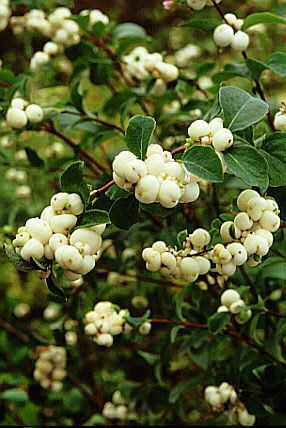Size
Ultimate height
1–1.5 metresTime to ultimate height
10–20 yearsUltimate spread
1–1.5 metresGrowing conditions
Moisture
Moist but well–drained, Poorly–drained, Well–drainedpH
Acid, Alkaline, NeutralColour & scent
| Stem | Flower | Foliage | Fruit | |
| Spring | Blue Green | |||
|---|---|---|---|---|
| Summer | Green White | Blue Green | ||
| Autumn | Blue Green | White | ||
| Winter |
Position
- Full shade
- Full sun
- Partial shade
Aspect
South–facing or North–facing or West–facing or East–facing
Exposure
Exposed or ShelteredDrought resistance
Yes Hardiness
H6Botanical details
- Family
- Caprifoliaceae
- Native to GB / Ireland
- No
- Foliage
- Deciduous
- Habit
- Bushy
- Potentially harmful
- Harmful if eaten. Wear gloves and other protective equipment when handling
- Genus
Symphoricarpos are twiggy deciduous shrubs, sometimes suckering, with small, simple leaves and tiny bell-shaped pink or white flowers, followed by juicy white pink or purple berries
- Name status
Accepted
How to grow
Cultivation
Easy to grow in most reasonably moist, fertile soil. Tolerant of pollution and all but the most extreme conditions. Thicket forming with an indefinite spread and has the potential to become a nuisance if not managed well
Propagation
Propagate by softwood cuttings in summer or hardwood cuttings in autumn. Rooted suckers can be transplanted in autumn
Suggested planting locations and garden types
- Low Maintenance
- Banks and slopes
- Hedging and screens
Pruning
Pruning group 1 or pruning group 2; sucker removal if necessary, in winter
Pests
May be susceptible to aphids
Diseases
May be susceptible to fungal leaf spots, powdery mildews, rust diseases, stem galls and honey fungus (rarely)
Get involved
The Royal Horticultural Society is the UK’s leading gardening charity. We aim to enrich everyone’s life through plants, and make the UK a greener and more beautiful place.
